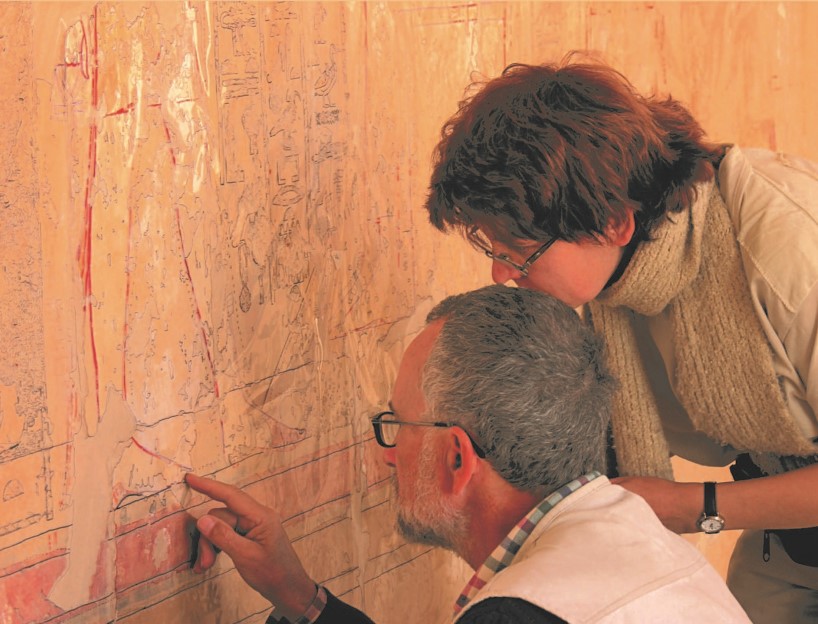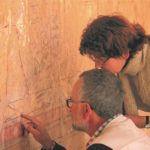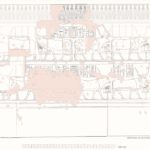Deir el-Bahari, Hathor Shrine
-
Project name:
Deir El-Bahari, Polish-French Epigraphic Mission: Hathor Project
-
Type of site:
temple
Location:
Upper Egypt
ThebesDating:
Hatshepsut (1479–1458 BC)
History of research:
Dates of PCMA mission’s work:
1992–2009
Type of research:
Documentation work
Directors:
Janusz Karkowski, Nathalie Beaux-Grimal
Co-operating institutions:
– Polish Centre of Mediterranean Archaeology, University of Warsaw
– Institut français d’archéologie orientale
– Egyptian Ministry of State for Antiquities
Additional information:
Janusz Karkowski conducted epigraphic studies in the Temple of Hatshepsut from 1971 (since 1979 in the framework of the Epigraphic Mission). The Polish-French Epigraphic Mission was created in 1992, as a result of an agreement between the PCMA UW and the IFAO. It was co-directed by Janusz Karkowski (PCMA UW) and Nathalie Beaux-Grimal (IFAO).
Description of the site and research:
The shrine is located in the south-western part of the Middle Courtyard of the Temple of Hatshepsut. Originally, a separate ramp led to it from the Lower Courtyard, but after rebuilding, it became accessible directly from the Middle Courtyard. The shrine is one of the largest and most important complexes in the temple. The main sanctuary is preceded by a bark hall, a vestibule with side niches, and two hypostyle halls.
The Epigraphic Mission’s goal was to prepare a monograph of the shrine. The work included studying the architecture of the complex, the phases of its construction, as well as the decoration of its walls, columns, and architraves. Recreating the wall decoration of the outer hypostyle hall required the verification of an earlier reconstruction, made in the 1920s and 1930s, which contained some errors. Therefore, the Mission not only created a complete documentation of the chapel but also undertook reconstruction works.
Research results:
Season by season – “PCMA Newsletter”:
- 2009 season
- 2008 season
- 2007 season
- 2005 season
- 2002 season
- 1997 season
- 1996 season
Beaux, N., Grimal, N., Pollin, G., Karkowski, J., Majerus, E. (2013). La chapelle d’Hathor – Temple d’Hatchepsout à Deir el-Bahari I. Vestibule et sanctuaires. Fasc. 1, texte; fasc. 2, figures; fasc. 3, planches (= MIFAO 129). Cairo: IFAO
Wieczorek, D. F. (2011). <a href=”https://pcma.uw.edu.pl/wp-content/uploads/pam/PAM_2008_XX/PAM_20_Wieczorek_203_211.pdf”>Building dipinti in the Temple of Hatshepsut. Documentation work, season 2007/2008, Polish Archaeology in the Mediterranean 20, 203–211</a>
Karkowski, J. (2007). <a href=”https://pcma.uw.edu.pl/wp-content/uploads/pam/PAM_2005_XVII/284.pdf”>Deir el-Bahari. The Epigraphic Mission: Hathor Project, Polish Archaeology in the Mediterranean 17, 255–261</a>
Karkowski, J. (2000). Znane zabytki od nowa odkrywane – publikacja materiałów o Kaplicy Hathor w kompleksie świątyni królowej Hatszepsut w Deir el-Bahari, Polska Akademia Nauk. Działalność Naukowa. Wybrane zagadnienia 9, 34–37
Karkowski, J. (1998). <a href=”https://pcma.uw.edu.pl/wp-content/uploads/pam/PAM_1997_IX/329.pdf”>Hatshepsut Temple, Epigraphic Documentation, Polish Archaeology in the Mediterranean 9, 43–50</a>
Karkowski, J. (1997). <a href=”https://pcma.uw.edu.pl/wp-content/uploads/pam/PAM_1996_VIII/353.pdf”>Hatshepsut Temple, Epigraphic Mission 1996, Polish Archaeology in the Mediterranean 8, 46–58</a>
Karkowski, J. (1996). <a href=”https://pcma.uw.edu.pl/wp-content/uploads/pam/PAM_1995_VII/380.pdf”>Epigraphic Mission at the Hatshepsut Temple 1995, Polish Archaeology in the Mediterranean 7, 61–68</a>
Karkowski, J. (1995). <a href=”https://pcma.uw.edu.pl/wp-content/uploads/pam/PAM_1994_VI/397.pdf”>The Hatshepsut Temple at Deir el-Bahari. The Epigraphic Mission, Polish Archaeology in the Mediterranean 6, 48–52</a>
Karkowski, J. (1994). <a href=”https://pcma.uw.edu.pl/wp-content/uploads/pam/PAM_1993_V/416.pdf”>The Hatshepsut Temple at Deir el-Bahari, 1993. The Epigraphic Mission, Polish Archaeology in the Mediterranean 5, 79–84</a>
Gallery:
-
Fot. M. Michałowska / Archiwum CAŚ UW
-
Fot. M. Michałowska / Archiwum CAŚ UW
-
Rys. Nathalie Beaux, Janusz Karkowski





